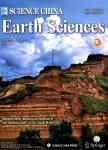New evidence of microbe origin for ferromanganese nodules from the East Pacific deep sea floor
New evidence of microbe origin for ferromanganese nodules from the East Pacific deep sea floor作者机构:Department of Earth Sciences State Key Laboratory of Mineral Deposit Research Nanjing University Nanjing China Second Institute of Oceanography State Oceanic Administration Hangzhou China State Key Laboratory of Mineral Deposit Research Nanjing University Nanjing China
出 版 物:《Science China Earth Sciences》 (中国科学(地球科学英文版))
年 卷 期:2000年第43卷第2期
页 面:187-192页
核心收录:
学科分类:08[工学] 0708[理学-地球物理学] 0824[工学-船舶与海洋工程] 0704[理学-天文学]
基 金:National Natural Science Foundation of China NSFC: 49733120 49973001
主 题:ferromanganese nodule microbic fluorescent microstructure clumpy microbe filamentous microbe.
摘 要:Using a fluorescence microscope and EPMA, abundant microbe bodies and clear mi-crobic fluorescent microstructure are determined in the ferromanganese nodules recently collected from the East Pacific deep sea floor. The microbic fluorescent structure shows a close relation to the formation of the ferromanganese nodules. According to their morphological features, the microbes are classified into two types: one is named clumpy microbe, which takes a bar-shaped manganese mineral as a pillar and grows like fasciculate coral, resulting in irregular cauliflorate nodules with rough surfaces; the other is called filamentous microbe, which grows in very thin arcuate and/or concentric circular laminae composed of a microbe layer and a metal (manganese and iron)-rich layer, leading to potato-shaped nodules with relatively smooth surfaces. It also can be seen that the two types of microbes are intergrown together, resulting in nodules complicated in compositions and shapes.



